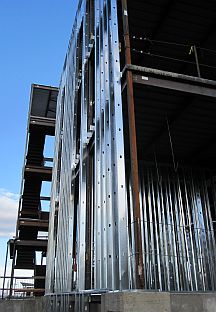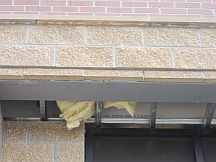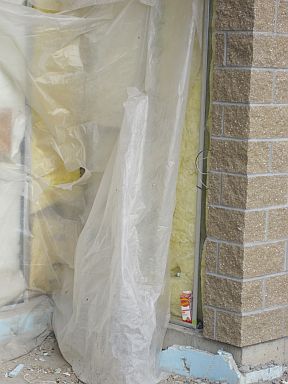
Neglectful Design
I understand why developers and contractors want to build commercial buildings out of steel. For cost and flexibility of design, it’s hard to beat steal beams, girders, and studs. The design error is to overestimate the R-value you achieve with steel-stud walls, given that steel is among the most conductive of building materials. Worse is the failure to identify or specify any type of air barrier for the building.
I don’t know whether the architect just has never heard of an air barrier, or that he or she assumes that the masonry veneer, the interior drywall, exterior sheathing, or some combination of materials constitutes an acceptable air barrier.
New Commercial Buildings That Fail
My friend, a mechanical engineer, designed the boiler for one of the first, of many, new, steel-framed buildings built in Helena, Montana. He read the plans, which said the steel-framed walls were R-11, and designed the boiler accordingly. Now most employees have their own personal electric space heaters and a maintenance man has to walk the building every evening to make sure that all those electricity hogs are turned off. My friend subsequently calculated the R-value using my infrared thermometer at an outdoor temperature of 10 degrees F. The R-value was 3.8!
You would think that the developer and contractor would learn from this early experience, but no. The new steel framed courthouse had moisture damage a week after the tenants moved in; condensation from the roof deck’s underside rained on the brand new ceiling tiles. Of course they blamed the roofers at first, and the roofers ascended the roof in a futile search for leaks. I tried to explain to both the architect and the developer why these buildings fail when they started building them 12 years ago, but had no luck penetrating their confident omniscience. I sure hope one of the hundreds of space heaters hard at work in these buildings never catches a waste basket on fire, setting off the fire sprinklers. With interior and exterior drywall, along with the rather immovable masonry veneer, the wet steel building might be a complete loss from rust, mold, and “sick building” syndrome.
One of the buildings, finished 8 years ago, has been renovated twice because of comfort complaints. Executives were wearing wool socks and long underwear to stay warm. I think they’re OK now with just a personal space heater.
Problems at the Thermal Boundary
There are a few explanations for the discomfort, moisture problems, and high energy bills.
1. The designers assume R-11 to R-21 from a steel-framed wall without exterior foam insulation, which is actually R-4 to R-10.
2. The workers install the insulation carelessly, creating voids and areas of the exterior building shell that aren’t insulated at all, further reducing an already low average R-value.
3. The designers assume that some unspecified building component serves as an effective air barrier. That’s assuming the designer thinks about an air barrier at all.
4. The workers don’t take the responsibility for building an air barrier that isn’t specified on the plans.
Any or all of these can lead to a flawed, or non-existent, thermal boundary in commercial buildings. This can cause discomfort for the people inside, health problems for the occupants, or damage to the building itself. It is imperative that designers learn and understand the importance of the thermal boundary and that the workers constructing the building implement the necessary steps to build the structure properly.
More Information at Our Bookstore
All the information necessary to understand insulation, air barriers, vapor barriers, thermal bridging, and other important building-design concepts is found in Residential Energy and The Homeowners Handbook to Energy Efficiency.


